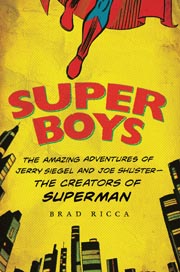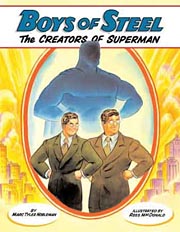Even though they are best known for the creation of Superman, Jerry Siegel and Joe Shuster were responsible for many more strips and features for DC Comics — many of which are still in use today as part of DC’s shared universe — and, at least in Siegel’s case, characters and popular features for other companies.
In the first part of this series we looked at characters co-created by Siegel and Shuster, culminating with their most well-known creation, Superman. This time, we pick up less than a year after Superman’s debut with Siegel’s first published character not co-created with Shuster.
Once again, I’ll also be linking to scans of the Who’s Who entries for the characters, where possible. Keep in mind they might mention developments from long after Siegel and Shuster left the company. But, regardless, help provide perspective on the impact and legacy of their creations. (For more about the the Who’s Who series, don’t miss a series of special episodes of the Fire and Water Podcast, hosted by Rob Kelly of Aquaman Shrine and Shag of Firestorm Fan, doing an issue-by-issue look at the series.)
 Hot on Superman’s heels and capitalizing on the growing wave of pro-American sentiment during the run-up to World War II, Red, White and Blue debuted in ALL-AMERICAN COMICS #1 (April 1939 cover date). The feature was Siegel’s first without Shuster, being illustrated originally by artist William Smith. It told light-hearted and often comedic adventures of three U.S. soldiers, Marine Red Dugan, Army officer Whitey Smith and Navy officer Blooey Blue, who teamed up to combat spies, Axis agents and other anti-U.S. sympathizers, both in America and abroad, often aided by or under the direction of FBI agent Doris West.
Hot on Superman’s heels and capitalizing on the growing wave of pro-American sentiment during the run-up to World War II, Red, White and Blue debuted in ALL-AMERICAN COMICS #1 (April 1939 cover date). The feature was Siegel’s first without Shuster, being illustrated originally by artist William Smith. It told light-hearted and often comedic adventures of three U.S. soldiers, Marine Red Dugan, Army officer Whitey Smith and Navy officer Blooey Blue, who teamed up to combat spies, Axis agents and other anti-U.S. sympathizers, both in America and abroad, often aided by or under the direction of FBI agent Doris West.
The strip’s popularity was, ostensibly, initially quite high. In addition to regular, monthly appearances in ALL-AMERICAN COMICS, the feature appeared in the 1940 issue of NEW YORK WORLD’S FAIR COMICS and, shortly thereafter, the first two issues of ALL-STAR COMICS. With the Justice Society of America taking over that title in issue three, the feature was moved to the newly launched WORLD’S FINEST COMICS and then, in mid-1942, to COMICS CAVALCADE.
Which and how many stories Siegel wrote for the strip seems to be the matter of some question; no writer or artist is credited in a majority of Red, White and Blue stories. However, Siegel is believed to have written most of the feature’s stories through the end of 1940. At that point, he focused primarily on the feature’s stories in WORLD’S FINEST COMICS until the feature moved to COMICS CAVALCADE. After Siegel’s departure, the strip continued in both magazines until late 1945. Since, the characters have rated a few non-significant appearances, but mostly have become a footnote in DC continuity. The idea was revived, however, in 1996 by Mark Waid and Alex Ross in the non-continuity mini-series KINGDOM COME, where Red, White and Blue were radically re-envisioned as a trio of androids under the thrall of Lex Luthor.
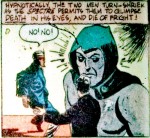 By early 1940, Superman had become a multimedia sensation, with two comic books titles showcasing his exploits, newspaper strips seven days a week and a soon-to-be-smash radio show in the works. And yet, despite this success, Siegel was not resting on his laurels. In fact, he was about to launch what would go on to become his second most-famous co-creation: the Spectre.
By early 1940, Superman had become a multimedia sensation, with two comic books titles showcasing his exploits, newspaper strips seven days a week and a soon-to-be-smash radio show in the works. And yet, despite this success, Siegel was not resting on his laurels. In fact, he was about to launch what would go on to become his second most-famous co-creation: the Spectre.
With Siegel perhaps exercising the same muscles that made one of his and Shuster’s first creations, Doctor Occult, such a hit, the Spectre debuted in MORE FUN COMICS #52 (February 1940 cover date), with the adventures illustrated by Bernard Baily. The Spectre told of Jim Corrigan, a young policeman gunned down in the line of duty by mobsters. His soul is then called by “the Voice” (a not-so-vague analogue for God) to remain on Earth and battle crime. The ghostly Spectre, possessing a vast array of cosmic and mystical powers, emerges, seeking vengeance on Corrigan’s murderers, as well as other criminals and mystic threats.
The Spectre’s stories originally were quite dark and moody by Golden Age standards, though they became increasingly lighter in tone following the introduction of Percival Popp, a bumbling comic-relief sidekick character, in MORE FUN COMICS #74 (December 1941 cover date). Like with Red, White and Blue, the character’s popularity was high. In addition to MORE FUN COMICS, the character was featured in solo adventures in the first two issues ALL-STAR COMICS and continued to make regular appearances as part of the Justice Society of America beginning with issue #3.
Siegel’s final Spectre story came in late 1942. Despite his absence, however, the character continued to be a staple of MORE FUN COMICS and, alongside the Justice Society, ALL-STAR COMICS until late 1944. His final Golden Age appearance came in MORE FUN COMICS #101 — coincidentally, the same issue that featured the debut of another Siegel/Shuster creation. The Spectre then vanished for more than two decades before being revived by Gardner Fox and Murphy Anderson in the pages of SHOWCASE and JUSTICE LEAGUE OF AMERICA in 1966.
The character has been a mainstay of DC Comics ever since, supporting extended runs of his own series on several occasions, not to mention recurring roles in ensemble books and frequent guest appearances, with legendary creators such as Jim Aparo, Michael Fleischer, Neal Adams and John Ostrander among those chronicling his adventures. Within DC continuity, other characters have taken up the Spectre’s mantle, as well, making the concept into a legacy character and providing even more opportunities for stories.
The Spectre has also leaped off the comics page and into animated form in at least three episodes of “Batman: The Brave and the Bold” (voiced by Mark Hamill), as well as his own direct-to-DVD animated short in 2010 (voiced by Gary Cole). He also has been given appearances in video games, such as DC Universe Online, action figures, was visually referenced in an episode of “Smallville” and, as of late 2011, reportedly was being developed by Fox for his own live-action show. (The Spectre’s entry from WHO’S WHO #21)
 Roughly a year and a half after the Spectre’s debut, Siegel’s next creation premiered in the form of the Star-Spangled Kid. Much like with Red, White and Blue, the strip again attempted to capitalize on pro-American sentiment, as well as the growing popularity of sidekicks. But the Star-Spangled Kid strip took the sidekick idea and gave it a twist — because, this time, the kid was the hero, and the adult was the sidekick.
Roughly a year and a half after the Spectre’s debut, Siegel’s next creation premiered in the form of the Star-Spangled Kid. Much like with Red, White and Blue, the strip again attempted to capitalize on pro-American sentiment, as well as the growing popularity of sidekicks. But the Star-Spangled Kid strip took the sidekick idea and gave it a twist — because, this time, the kid was the hero, and the adult was the sidekick.
With art originally by Hal Sherman, the strip told tales of Sylvester Pemberton and Pat Dugan, who fought Nazis and other war-time saboteurs as the patriotic-themed duo, the Star-Spangled Kid and Stripesy. The public got its first glimpse of the characters in a three-page preview in ACTION COMICS, but the strip made its official debut in STAR SPANGLED COMICS #1 (October 1941 cover date). The character shortly after were given more exposure in LEADING COMICS as part of the newly formed Seven Soldiers of Victory.
Siegel left the strip in mid- to late-1942 after fewer than 40 stories featuring the pair. During this time Siegel was serving in the U.S. Army as part of the war effort and focused the majority of his writing time on Superman. However, despite Siegel’s departure, the strip continued through late 1948, even gaining a second feature in WORLD’S FINEST COMICS from 1942 to 1945.
The characters later resurfaced in JUSTICE LEAGUE OF AMERICA in 1972 and have been used off and on ever since, undergoing a number of changes in the hands of other writers, being linked with the Golden Age Starman, and, in the case of the Star-Spangled Kid, even having other characters take up the mantle within DC continuity. (Star-Spangled Kid’s entry from WHO’S WHO #21 and Stripesy’s entry from WHO’S WHO #22)
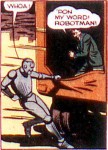 Just a short six months after the debut of the Star-Spangled Kid, STAR SPANGLED COMICS gained a second Siegel-written feature in the form of Robotman, the final Siegel co-creation for DC Comics (though not the last to be published.)
Just a short six months after the debut of the Star-Spangled Kid, STAR SPANGLED COMICS gained a second Siegel-written feature in the form of Robotman, the final Siegel co-creation for DC Comics (though not the last to be published.)
Debuting in STAR SPANGLED COMICS #7 (April 1942 cover date) with art by Shuster Shop alum Leo Nowak, the strip told of Robert Crane, who was fatally shot. Following his death, Crane’s brain was transferred into a powerful robotic body, and he used his newfound life and abilities to not only bring his own killers to justice, but to fight a crusade against all crime. He also used plastic face masks and gloves to disguise himself and adopted a new civilian identity as Paul Dennis.
Again due to his service in the Army, Siegel left the strip in 1943 and is credited with writing only the first 19 Robotman stories. The strip continued on in the pages of STAR SPANGLED COMICS, however, until 1948, and then moving to DETECTIVE COMICS, where it stayed until the strip’s conclusion in 1953.The character was given a revival in the 1980s as a part of Roy Thomas’s ALL-STAR SQUADRON and YOUNG ALL-STARS, and has been used in a handful of stories, both in-continuity and not, in the decades since. (Robotman’s entry from WHO’S WHO #19)
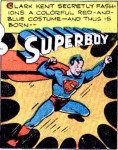 Last to be published by DC Comics, but by no means least, of the Siegel and Shuster co-creations is none other than Superboy. While obviously closely tied to Superman, when discussing the creations, because of how the character came into publication, it is important to look at Superboy as a separate creation.
Last to be published by DC Comics, but by no means least, of the Siegel and Shuster co-creations is none other than Superboy. While obviously closely tied to Superman, when discussing the creations, because of how the character came into publication, it is important to look at Superboy as a separate creation.
Banking off the already smash-hit Superman, the idea of a Superboy series — chronicling “the adventures of Superman as a youth” — first was proposed by Siegel and Shuster in November 1938. DC quicky declined. The men re-pitched the idea in December 1940, even going so far as to include a script for the first story and detailed ideas for future stories. DC again declined. Four years later, however, while Siegel was serving in the Army, DC published the Siegel-written, Shuster-drawn story in MORE FUN COMICS #101 (January-February 1945 cover date).
As has been oft-detailed elsewhere, the story’s publication, which came without Siegel’s consent, only served to widen the growing rift between DC Comics and the team of Siegel and Shuster. Aside from a 1947 flashback story told within the confines of a Superman story, the character’s debut was Siegel’s only Superboy story until 1959, when he returned to DC Comics, writing stories for the entire Superman line until 1966. For Shuster’s part, he would illustrate a few more Superboy tales, but fewer than a dozen before bowing out of comics entirely within a decade.
Despite the lack of involvement from his creators, the Boy of Steel went on to great success. The character remained in near-continuous publication until the mid-80s and iterations of the character have appeared in other forms of media, even a television show that ran for four season. In the mid-90s, a new version of Superboy, now a wholly new creation and no longer a younger Superman, debuted and that version has remained in publication, in one form or another, ever since, as well.
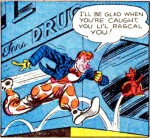 Following their departure from DC, Siegel and Shuster reteamed with former editor Vin Sullivan at Magazine Enterprises for Funnyman.
Following their departure from DC, Siegel and Shuster reteamed with former editor Vin Sullivan at Magazine Enterprises for Funnyman.
The character debuted in FUNNYMAN #1 (January 1948 cover date). It told of comedian Larry Davis who fought crime as the comedic Funnyman. The series allowed Siegel to exercise his love of comedy and slapstick, telling humorous stories — but still in the vein of the superhero genre that made him famous. Unfortunately, the series lasted a mere six issues. It later was given new life in the form of a newspaper strip. Unfortunately, the strip lasted only approximately a year, and Funnyman then faded into obscurity.
After the newspaper’s end, Siegel and Shuster, though they remained close friends through Shuster’s death in 1992, had no more creative collaborations. Shuster’s diminishing eyesight and financial difficulties of both men brought on by their legal battles with DC Comics made more collaborative efforts between the two increasingly difficult.
I hope to post a more in-depth look at the oft-maligned Funnyman in the future.
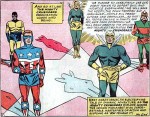 In 1965, Siegel joined Archie Comics as part of revival of their super-hero line. Characters written by Siegel during this time include the Fly, the Shield, a super-hero take on pulp favorite the Shadow, the Web, the Black Hood and Steel Sterling.
In 1965, Siegel joined Archie Comics as part of revival of their super-hero line. Characters written by Siegel during this time include the Fly, the Shield, a super-hero take on pulp favorite the Shadow, the Web, the Black Hood and Steel Sterling.
While a majority of the characters written by Siegel during this period were not created by him, Siegel was at least partially responsible for reinventing them from their Golden Age roots, and is credited with joining them together into a team as the Mighty Crusaders.
These stories were both playing off the popularity and also a tongue-in-cheek parody of the recently successful Marvel Comics heroes line. While often dismissed as camp and disappearing from comics stands by late 1967, Siegel’s work on the Mighty Comics line of heroes provided rejuvenation at a critical point in history for the characters which have since become comic mainstays, with stories coming from a variety of publishers, including at least two stints at DC Comics, on a regular basis ever since.
Throughout his career, Siegel also created a number of other minor features for various comic book publishers. A majority of these were not major hits and, in fact, only lasted a few issues. These features, which include characters such as Mr. Muscles, Tiger Girl and the Owl, will be looked at more closely in the future.
But as for now, that’s it. Hopefully this series has served to cast a bit more light on the many creations of Jerry Siegel and Joe Shuster. Stay tuned to future blog entries for more on all of these characters and Siegel’s and Shuster’s contributions to both them and comics as a whole!


